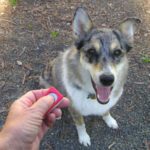When the vet diagnosed her four-year-old Beagle with lead poisoning, Jenna was devastated. Where on earth did the dog find lead to ingest? His symptoms were heart-wrenching.
It took a few hours and a thorough search of the house to discover the source. The Beagle had been chewing on some draperies in the rec room. Inside the drapes were lead weights.
Causes
Lead poisoning or toxicity is officially known as plumbism, according to PetPlace.com. Dogs manage to encounter lead in a number of different ways. Perhaps most common is contact with lead-based paint, paint chips or paint dust during home remodeling or renovation. Paints manufactured earlier than 1977 have high levels of lead.
Dogs sometimes grab lead weights used as fishing sinkers and lead pellets and shots used in guns. In addition to drapery weights, common household items like rug padding, foil from bottle tops and linoleum have high lead contents.
A dog might encounter plumbing and roofing material or automotive items like batteries, leaded gasoline, discarded oil and wheel weights. Construction materials high in lead include solder, caulking and putty.
Critterology.com reports that dogs are more likely to be exposed to lead through household contamination than by pet toys. Old paint contains a content that’s up to 40 percent lead. Overall, lead absorption is greatest in young animals.
When a pregnant or nursing dog ingests lead, it can reach her puppies. Lead toxicity can result in anemia, gastrointestinal issues and problems involving the nervous system.
Symptoms
Owners should be sure to call a vet promptly if they observe symptoms like loss of appetite, vomiting, diarrhea or abdominal pain. A dog might also show anxiety, muscle tremors, weakness, lack of coordination or aggressive behavior.
Some pets experience seizures, blindness, deafness or mental dullness. Behavioral changes might be apparent. Increased thirst and urination, shortness of breath and not tolerating exercise are common.
Diagnosis and treatment
To diagnose lead poisoning, a veterinarian will take the dog’s complete medical history and perform a comprehensive physical exam. Tests include a complete blood count (CBC), serum biochemistry evaluated at a lab and a measure of blood lead concentration.
Veterinarians also order X-rays of the dog’s abdomen and chest in an attempt to spot any lead objects or an enlarged esophagus, which is a sign of lead poisoning, or pneumonia. In some cases, vets make a diagnosis based on lead concentrations in the dog’s feces instead of in his or her blood.
Treatment
The most important things to do in lead poisoning cases are treating the symptoms, giving supportive care, removing the source of lead and providing chelation therapy. This therapy consists of providing medications to bind the lead in the dog’s body. The drugs used bind lead in the bloodstream and help the animal excrete it through the kidneys. Medications include calcium ethylene diamine tetra-acetic acid (CA-EDTA), penicillamine and succimer.
To remove any lead residue from the pet’s stomach and intestines, vets perform gastric lavage. It might also be necessary to perform surgery to remove lead in the intestines. Vets usually administer IV fluids to reverse dehydration and help the dog excrete any lead. If the dog is having seizures, anticonvulsant medications like diazepam (brand name Valium), phenobarbital or pentobarbital can help control them.
Since there is no home care for lead poisoning in dogs, it’s essential to contact a vet right away if it’s possible that a dog has been exposed to items that contain lead or is showing the symptoms of lead poisoning.
Sources:
PetPlace.com site
Critterology.com site
Reference:
- PetPlace.com site
- Critterology.com site








